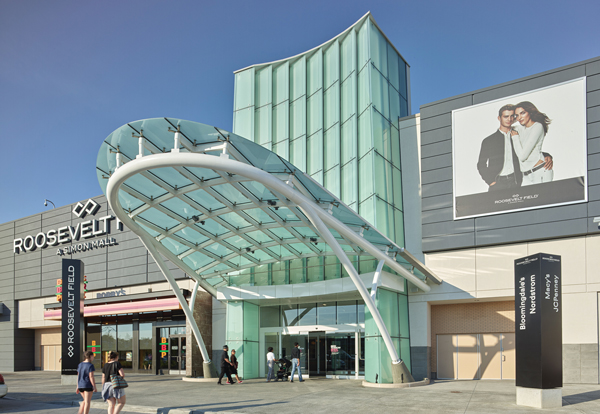Trending
REITs keep it classy — Class A, that is
By continuing to sell off lower-tier properties, real estate investment trusts are trying to stay on the right side of the shifting landscape

Retail real estate investment trusts have taken a beating since the end of last summer, with many of the major players posting double-digit drops in stock prices as several retailers announced store closings. However, despite the continuing influx of grim news — including Sears’ announcement that it had “substantial doubt” it could survive — several retail REITs have recently begun to recover, and some analysts say they could even be undervalued.
“They have been underperforming the S&P 500, but there’s still opportunity,” said Calvin Schnure, a senior vice president at the National Association of Real Estate Investment Trusts (NAREIT). “REITs are in prime locations and can find new, good tenants. The fundamentals remain strong in the sector.”
Those fundamentals include funds from operations (FFO), which measures the cash generated by REITs and which analysts use because it accounts for property depreciation. FFO was up year over year in 2016 by 6.1 percent, according to NAREIT data. Dividends paid climbed 7.8 percent during the same period. Net operating income remained stable, and the fourth-quarter 2016 retail occupancy rate for REITs was 95.9 percent — the highest quarterly rate for the retail segment for the 17 years data has been recorded.
The current one-year returns are down a very steep 11.14 percent, which is worrisome. However, the five-year compound annual total returns as of the end of March were 7.65 percent, per the FTSE NAREIT U.S. Real Estate Index, so those investors who have been in it for the long haul are still doing fine.
Happily for REITs given the current retail environment, most are composed of Class A properties, as they’ve steadily been selling off their Class B and C holdings over the past few years. Of the 328 announced department store closings, roughly half will occur at mall properties, and of those, less than 10 percent will be at REIT-owned malls, according to a March report from Green Street Advisors.
“On the store closure list, there is very little exposure for publicly traded mall REITs,” said Steve Brown, senior vice president and senior portfolio manager for American Century Investments.
For most Class A malls, the news about closures from department stores like JCPenney, Macy’s and Sears doesn’t matter, said James Sullivan, managing director of BTIG. There’s a certain amount of retail failure every year, he said, and some of the big-name operators announcing closures have been hurting for some time. “This year, what’s a little different is we have seen an accelerated focus on and closures by the department stores,” said Sullivan. “But Sears had problems before people could spell ‘internet.’”
The positive about anchors closing is that owners can now get more money per square foot for the space from more productive retailers, said Sullivan, explaining that traditionally, anchors didn’t pay much rent — maybe $3 per square foot a month — because they used to be the traffic drivers. Now, when they’re replaced by a Dick’s Sporting Goods or an H&M, owners can get between $16 to $20 per square foot.

Roosevelt Field in Garden City, New York, houses both a Macy’s and JCPenney, two troubled retailers.
“It delivers a nice incremental return,” Sullivan said, adding that BTIG’s Class A properties are projected to grow at 3.6 percent for 2017, versus 2.9 percent for 2016.
Still, for the Class B players, which are usually located in smaller markets, it’s more of a challenge, and it can take longer to replace tenants. And, should future closings occur at REIT-owned malls, that would increase the risk factor.
Retail solutions
In addition to selling off less productive properties, mall and shopping center owners are replacing apparel retailers with stores that offer more of an experience or entertainment. “Technology stores are doing well, as are home improvement stores,” said Brown.
Owners are also sprucing up their malls and shopping centers to make them more appealing in order to draw more traffic.
The internet is often blamed for all the store closings. But according to Forrester Research, while online sales as a percentage of total retail sales were forecast at 12 percent for 2016, up from 10.5 percent the previous year, a fourth-quarter report released in February by the U.S. Census Bureau showed online sales accounting for just 8.1 percent of retail sales. Forrester’s forecast for 2017 is 12.7 percent.
So shoppers are still interested in brick and mortar, and quality malls and shopping centers do good business, experts say. Better quality doesn’t have to mean luxury, said Alexander Goldfarb, senior REIT analyst for Sandler O’Neill & Partners. It means having the most productive stores and growth.
Malls often do well when they are the only game in town. “There’s a lot of money to be made in middle-market shopping centers,” said Goldfarb. “If you’re in the middle of South Dakota or Wyoming or, say, Wichita, and you own the one mall in a one-mall town and nothing will get built around there, you’re in a good position.”
Analysts also see traditional online retailers opening brick-and-mortar shops in malls and centers, such as Warby Parker and Bonobos — where you can get custom-fitted, then have your products arrive by mail or pick them up when they’re ready. And let’s not forget Amazon, one of the first successful online retailers.
These retailers are adding physical locations to optimize operations. “Amazon is doing it for a reason,” Goldfarb said. “It’s dealing with returns, last-mile logistics.”
Economic factors
Three key economic factors that affect REITs are interest rates, inflation and the unemployment rate. The latter is the lowest it’s been in a decade. Inflation is still relatively modest, and fell in March for the first time in more than a year. That leaves interest rates.
Though the Federal Reserve increased its benchmark interest rate in March, and higher rates usually put pressure on real estate, rates are still near all-time lows and haven’t yet affected REITs, said analysts. “It might need to be above 3 percent to have an impact,” said Goldfarb.
Some policies of the Trump administration also could affect REITs.
“If [Trump] is able to reduce corporate or personal income taxes, that will be perceived as a positive on GDP growth and in general,” said Brown.
In the meantime, the retail REITs analysts say are positioned well include Simon Property Group, Brixmor Property Group, Federal, Macerich, GGP and Taubman.
“The retail sector is not going away, it’s just changing,” said Schnure. “Retail REITs are paying close attention to what customers are looking for, and consumers are coming to look at the goods. And those are the types of stores [REITs] are choosing to have in their malls.”




